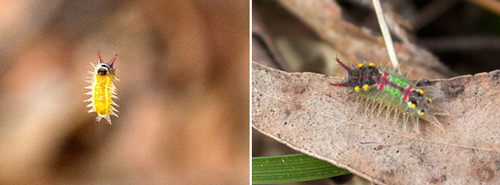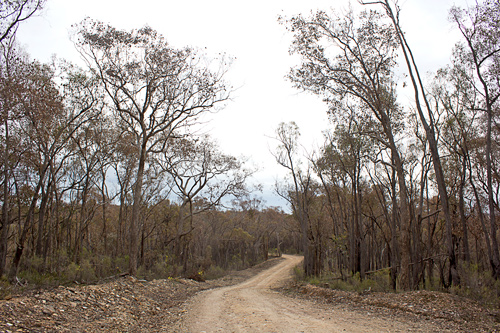The beautiful creature pictured below is an early instar caterpillar, from the genus Doratifera, probably Doratifera oxleyi. These moths are commonly called cup moths. It was found in suspended by a thread in an area of severely damaged bushland in the Diggings Park this week.

Cup moth caterpillar: It’s less than a centimetre long, and you can’t deny it’s pretty— but don’t touch it! We’re not sure if it’s the creature that’s eating our bushland. Photo: Bronwyn Silver, 14 August 2012
Cup moths Cup moths ‘belong to a small group of moths that have unusual slug-like caterpillars that are often beautifully marked and coloured. They derive their name from the cup shaped cocoons made by the caterpillars when they pupate. There are several different species of cup moth that feed on eucalypts and other native plants. The caterpillars differ in colour, pattern and size but they all have the characteristic slug-like appearance with clusters of spines on their bodies. The spines can inflict a sharp and painful sting, rather like a nettle and the caterpillars are often known as ‘stingers’. The stings may cause local inflammation if they touch bare skin.’ [ref: Department of Primary Industry, SA]
We mistakenly reported last week that the enormous damage inflicted on eucalypts in the south end of the Shire was caused by lerps. Now we believe that the damage is caused by a leaf miner of some sort, and have suspicions about the cup moth–but we’re not sure. Theories are invited.





 Click on image for info/order page
Click on image for info/order page Click on image for info/order page
Click on image for info/order page Click on image for info/order page
Click on image for info/order page





















There was a major outbreak of Cup moth caterpillars around 10 years ago when they defoliated large areas of forest in this area they could be heard chomping away on the leaves there was so many of them,they are locally known as” stinging joeys.”They have almost disappeared in recent times but could be building up for another infestation.
Walkers on FOBIF’s Middleton Creek walk today saw lots of the caterpillars on leaves and even crawling around Great Dividing Trail sign posts. Apparently they’re also called Chinese Junks, because of a vague similarity to the ship.
We live in Guildford and are surrounded by native bushland including many trees on our property. I’ve only recently noticed the cup moth caterpillars after being ‘stung’ by one whilst cleaning up outside, the burning sensation subsided after an hour or so. Now I have realised that these caterpillars have been eating many trees and are quite destructive indeed. I didn’t notice them at all last year but there seems to be thousands of them at the moment…I spent yesterday listening to them chomp away at leaves on the ground and in trees, they are everywhere! We are considering spraying them, but not sure how effective this will be considering how many there are.
[FOBIF note: Infestations of these moths are not well understood. We’ve heard that recovery of trees can be rapid [possibly from spring to autumn]–but that’s under good conditions, and general forest health [which includes good biodiversity] can be a factor. That’s why FOBIF is interested in DSE’s plans to burn infested areas.]
I think that it’s possible that we are going to have another infestation of Doratifera oxleyi (The Painted Cupmoth) next spring. Although not as numerous as in 2012, I have noticed dozens of the adult moths round lighted windows here in Vaughan for the past ten days. Their caterpillars (Stinging Joeys) will be defoliating eucalypts again. The trees seem to recover quickly but after this recent prolonged drought they will be under extra stress, which may be of concern.
Have planted many long leaf box trees last Spring and find now that lots have been almost completely devoured by a caterpillar (greenish with a small amount of red and often a single white band) Is this the cup moth caterpillar and how do you stop them from eating your trees up??
Meg, it looks like you’ve got the moth that’s currently chewing its way through lots of local bush for the second time in a couple of years. Trees do recover–as long as they’re not subjected to repeated attacks. We’re not sure about control. For what it’s worth, DEPI offers the following advice [http://www.dpi.vic.gov.au/forestry/pests-diseases-weeds/pests/cup-moth-alert]: ‘Cup moth larvae have several natural enemies. They are often parasitised by flies and wasps and are susceptible to a virus disease. Predatory insects such as shield bugs also attack the larvae. Chemical control, although it is likely to damage some natural enemies, may be necessary to protect young trees from complete defoliation.’